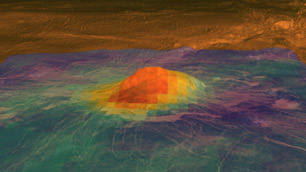
April Editorial
Volcanic activities on Venus

April Editorial
Volcanic activities on Venus
|
Volcanoes are not restricted to our planet. Evidence of past volcanic activity has been found on most planets in our solar system, and indeed, on many of the moons of those planets as well. The evidence for this is mainly volcanic craters which have been observed by astronomers. Most of the volcanoes which created the craters were active millions of years ago when the solar system was much younger and the planets/moons had higher internal temperatures. Consequently we know much less about active volcanoes other than on Earth. (Active volcanoes are defined as currently erupting or having erupted at some time in human history.) Nevertheless, scientists have gained more data from recent eruptions on Jupiter's moon lo, Neptune's moon Triton and Enceladus, a moon of Saturn. Most of this volcanic activity is very different from that which Earth-based vulcanologists are familiar with. The volcanoes on extra-terrestial moons are cryovolcanoes; so called because instead of erupting molten rock, these volcanoes eject cold or frozen water, ammonia or methane.
|
The exception is Jupiter's Moon lo. lo is very far from the Sun, and therefore should be extremely cold. But because it orbits Jupiter, the gravitational forces of Jupiter and the giant planet's other moons exert immensely strong "pulls". Io is actually continuously deformed from strong internal tidal forces. These produce a tremendous amount of internal friction, and this heats the moon, causing intense volcanic activity. As well as gasses, scientists believe that silicate rock or molten sulphur may be present as well. Also the data obtained from around the vents suggests that Io has been resurfaced with a flat layer of new material, and the inference is that this has come from lava similar to that of terrestrial volcanoes. | |
|
Unlike distant moons such as Triton or Enceladus, planets closer to the Sun are rocky and should produce volcanoes similar to those on Earth. But the question is, how active are these volcanoes? There is some evidence of recent volcanic activity on Mars, although this isn't conclusive. However, the research just published in the journal Science shows evidence that Venus is still reshaping its surface—as well as cooling its interior—through volcanic outpourings similar to that of the Hawaiian or Icelandic volcanoes on Earth. This recent findings come from combining data from NASA's Magellan mission in the early 1990s with new surface heat data. This data comes from instruments on the European Space Agency's Venus Express spacecraft which has been orbiting the planet since April 2006. By overlaying the heat data over a topographical map from the Magellan spacecraft, scientists found hot-spots in three volcanic regions. Relatively young lava flows have been identified by the way they emit infrared radiation. This suggests that Venus still has active volcanoes. Sue Smrekar from the Jet Propulsion Laboratory is the leading author of the Science paper. She explains: "We had data that showed areas that look very much like Hawaii, geologically speaking. They had broad topographic swells, volcanoes at the top and, most importantly, a gravity anomaly that indicated there was hot stuff deep down on the inside." The data from the Infrared Thermal Imaging Spectrometer showed temperature differences between the planet's surface and the three craters. Although the differences were small, they showed that these craters were hotter than the adjacent surface. Scientists have previously detected plumes of hot material rising from deep under Venus' surface. These plumes have probably produced significant volcanic eruptions. A mantle plume pushes up to the surface melting material in the planet's crust and causing volcanoes. Although the researchers are certain that the volcanoes at the hot-spots they have studied are less than 2.5 million years old, Sue Smrekar thinks that they are much younger than that. The data shows rocks which have a high iron content. As lava flows erupt the lava starts interacting with the atmosphere straight away. The iron breaks down or weathers as it would on Earth, but to much greater extent because of the harsher atmospheric conditions on Venus which has a surface temperature hot enough to melt lead. The planetary atmosphere also contains much more carbon dioxide and sulphur dioxide than Earth, and both gases react with iron. Because the iron content in the hot-spots is much higher than elsewhere in the crust of Venus, this suggests that these rocks underwent relatively little degradation, which in turn suggests that they are relatively young. So the lava flows are younger than 2.5 million years and probably much younger (maybe 250,000 years or less), indicating that Venus is actively resurfacing. Reference:
| |
| _______________________________ | ||||
| Home | | | Shopping | | | Database |
© Biscuit Software 2004-2015
All rights reserved